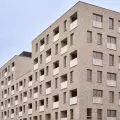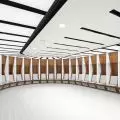Warsaw is increasingly betting on nature, and it's not just about new squares and parks. More and more green roofs are also appearing in the capital, which are being established not only on residential, office and commercial buildings, but also on university buildings. In this category, the green gardens of the Warsaw University Library in Powisle, which have become an important attraction in the city, attract the most attention. However, right next door is a lesser-known and newer green roof - at the UW's Faculty of Neophilology. How was it created there and what makes it stand out?
Dörken, the building of the UW's Department of Neophilology
© Dörken Delta
The building of the UW Department of Neophilology and Applied Linguistics is a research and teaching building, which is one of the largest investments of the UW's multi-year program in terms of area and financial outlay. It employs modern green building solutions, of which the public green roof is a particular highlight. The last phase of construction was completed in 2022, and due to its use of sustainable solutions, the building was honored with the Architecture Award of the President of the City of Warsaw. The green roof covers 800 sqm and is overgrown with flowers, grasses and shrubs, watered by rainwater. One can walk on it admiring the panorama of left bank Warsaw. You can also see the Old Town, the tops of the Palace of Culture and the skyscrapers in the center.
The green roof at the UW's Faculty of Neophilology definitely contributes to the attractiveness of the place and creates additional space for students to study and relax. At the same time, it cleans the air of carbon dioxide, and during rainstorms, it relieves the pressure on the city's sewage system by collecting water. Cities and investors are becoming increasingly aware of the benefits of green roofs, which is why such structures are increasingly being built in mixed-use facilities. One of the most recent interesting examples is the currently expanding Municipal Solid Waste Disposal Plant, which will feature a green roof of as much as 24,000 sqm, explains Piotr Pytel, technical advisor at Dorken Delta.
Dörken, courtyard in the UW Department of Neophilology building.
© Dörken Delta
Construction of the green roof on the Faculty of Neophilology at UW
The construction of the green roof on the UW Department of Neophilology building was made possible by the use of inverted roof technology. Durable materials were also used to support the growth of plants and their city-friendly functioning. Among others, DELTA®-FLORAXX 40H accumulation and drainage mats were used, which allow the retention of about 19.6 l/m² of rainwater and provide additional protection of the waterproofing against microbial damage. Care was also taken to ensure high water vapor permeability, using DELTA®-VENT RR diffusion film. Used in an inverted roof as a separation mat, it allows both water protection and moisture to move out of the thermal insulation. Both products were created by Dorken, a leader in developing solutions for green roofs.
The Faculty of Neophilology building at the University of Warsaw was developed in accordance with sustainable practices. The green roof is one of the important elements to bring more plants into the city. At the same time, the entire building blends into the landscape of old and new Powisle buildings. We have also implemented other green building and energy-saving solutions in the building, such as photovoltaic panels and the ability to remotely control the air conditioning system. There are also several courtyards which provide light to the building and additional space covered with vegetation. The building has also been adapted to the needs of people with disabilities," explains Michal Filipek, Senior Project Manager at Arup, the company providing investor supervision for the construction of the UW's Faculty of Neophilology and specializing in sustainable engineering.
Construction of the UW's Faculty of Neophilology building began in 2006 on the site of a 1980s tin building, and the project was divided into phases, with the first completed in 2012 and the last in 2022. The total area of the building is nearly 28,700 sq.ft. and the usable area is nearly 25,000 sq.ft. To this day, the project remains an important inspiration for implementing sustainable solutions.





















